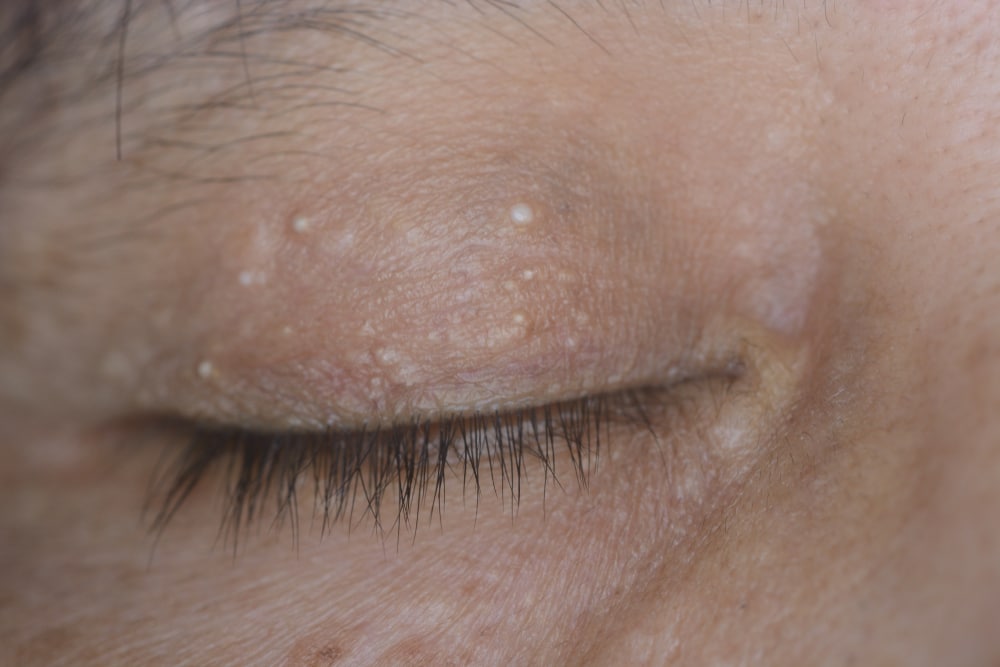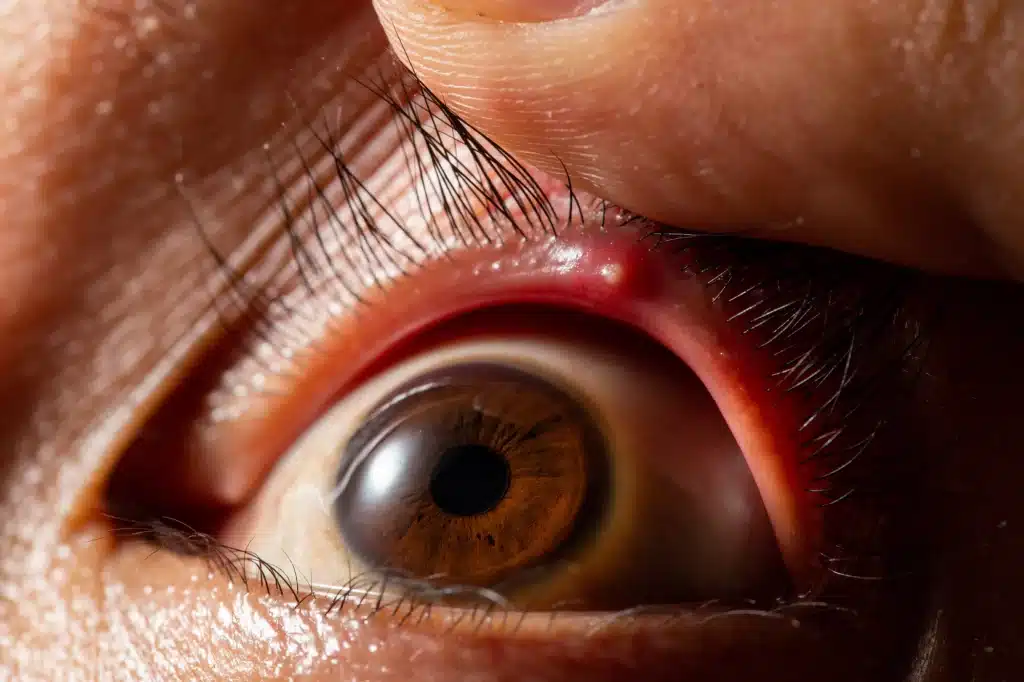Medically Reviewed by: Edward C. Wade, M.D., F.A.C.S.
How to Lift Eyelids and Excess Eyelid Skin
Excess eyelid skin can be frustrating for more than cosmetic reasons. When your excess eyelid skin begins to hang over your eyelashes, it can cause both discomfort and vision problems. Luckily, patients who are researching how to lift eyelids and eyelid surgery in Houston have an excellent resource in Eye Center of Texas.
Let’s go over what can cause excess eyelid skin and answer a few of the most commonly asked questions regarding excess eyelid skin in the process.
What is excess eyelid skin called, and what causes eyelids to droop?
In everyday vernacular, most people refer to excess eyelid skin as having “droopy eyelids.” Others refer to the condition as “Lazy eye,” although this nomenclature is more likely to be in reference to amblyopia (a weakness in the eye itself). Excess eyelid skin can occur for a variety of reasons. Here are some of the most common causes of droopy eyelids, along with clinical names.
Ptosis
Ptosis, the loosening of the upper eyelids’ muscle strength, is the most common of these conditions. As you age, the muscle that holds up your eyelid — the levator — can lose its elasticity and/or weaken. When this occurs, your upper eyelid can droop and start to block the pupil and cause vision problems. Ptosis is also a result of congenital conditions (particularly in children), eye diseases, eye trauma, botox injections, or as an aftereffect of eye surgery.
Dermatochalasis
Like ptosis, dermatochalasis is caused by a weakening and loss of elasticity — but in this case, the weakening takes place in the connective tissue of the very front of the eyelid. Dermatochalasis is called “baggy eyes” informally and can be caused by either separate diseases or a congenital condition. Dermatochalasis often happens in conjunction with blepharitis, an inflammation of the eyelids caused by the congestion of oil glands found at the base of each eyelash.
Note: Dermatochalasis is often confused with blepharochalasis. Both conditions result in lax, excess eyelid skin, but whereas dermatochalasis is typically involutional (related to aging), blepharochalasis is caused by the atrophy (degeneration) of eyelid tissues after long-term or chronic attacks of periorbital edema (swelling or puffiness of the eyes). Blepharochalasis is a rare syndrome.
Ectropion and Entropion
When people think of excess eyelid skin and how to lift eyelids, they often have the upper eyelids in mind. However, patients can also suffer from excess eyelid skin in the lower lids, which results in the conditions of ectropion and entropion.
Entropion occurs when weak lower eyelid muscles allow the skin of the lower eyelid to droop inward. When this sagging occurs, the lower lashes are constantly in contact with the cornea and can cause tearing, irritation, and a sensation of constantly having something in your eye.
Ectropion occurs when weak lower eyelid muscles allow the skin of the lower eyelid to droop outward. When this sagging occurs, the upper and lower eyelids don’t meet, causing irritation, dryness, and excess tearing.
What can I do about droopy eyelids? Blepharoplasty and non-surgical options.
While there are a few types of eyelid surgery, the most common is blepharoplasty. Sometimes used as a cosmetic procedure, blepharoplasty involves the removal of excess skin, muscle, and fat. Blepharoplasty can also tighten or strengthen sagging muscles when applicable. The procedure can be performed on both the upper and lower eyelid.
Many insurances cover blepharoplasty procedures intended to help vision problems. Check with your ophthalmologist at Eye Center of Texas to see if you meet your insurance qualifications for coverage.
Non-surgical options may include the regular use of artificial tears, eye shields (to retain eye moisture at night), and taping (for entropion only). Your ophthalmologist can instruct you in best practices with regard to these treatments.
There has been a recent increase in online videos professing to help individuals get rid of excess eyelid skin with the regular practice of facial exercises and the use of tape. These exercises do not work, and patients should only use tape as instructed by a trained professional.
When should you contact a professional about excess eyelid skin?
Excess eyelid skin can cause your brows to ache (from constantly trying to raise your eyebrows/lids. It can also cause reduced peripheral vision. If left untreated, more advanced cases of droopy eyelids can lead to additional vision issues and complications.
If your excess eyelid skin causes you pain, affects your vision, or develops suddenly (overnight or in just a few hours), contact your ophthalmologist as soon as possible.
Suffering from excess eyelid skin? Have more questions?
Whether your excess eyelid skin is bothering you for cosmetic or vision-related reasons, the Houston eyelid surgeons at Eye Center of Texas can help. Our eye doctors, including the esteemed Dr. Mark L. Mayo and Dr. Edward C. Wade, have decades of experience helping Houstonians overcome eye and vision problems.
We’re here to answer any questions you may have regarding eyelid surgery, as well as more general questions, from “What do I need to know about LASIK surgery recovery” to, “What is the difference between being nearsighted and farsighted?”
To discuss your options, request an appointment with one of our ophthalmologists by calling 713-797-1010 or contact us online today.
Other Helpful Articles by Eye Center of Texas:
Related Articles
Financing Options Available
Apply today to find a financing option that meets your needs.
Our Locations
Houston/Bellaire
6565 W. Loop S., Suite 650Bellaire, TX 77401
Medical Office:
713-797-1010
Medical Fax:
713-357-7276
LASIK/Near Vision:
Office: 713-395-1515
Fax: 713-357-7278
Pasadena
4415 Crenshaw RoadPasadena, TX 77504
Medical Office:
281-977-8800
Medical Fax:
281-977-8877
Sugar Land
15200 S.W. Freeway, Suite 130Sugar Land, TX 77478
Medical Office:
281-277-1010
Medical Fax:
281-277-4504
Clear Lake
455 E. Medical Center Blvd., Suite 110Webster, TX 77598
Medical Office:
281-332-1397
Medical Fax:
281-282-9152
Katy
Greenhouse Medical Plaza2051 Greenhouse Road, Suite 110
Houston, TX 77084
Medical Office:
346-547-7070
Medical Fax:
281-214-2971
The Woodlands/Conroe
100 Medical Center Blvd., Suite 118Conroe, TX 77304
Medical Office:
936-647-1610
Medical Fax:
936-647-1620


